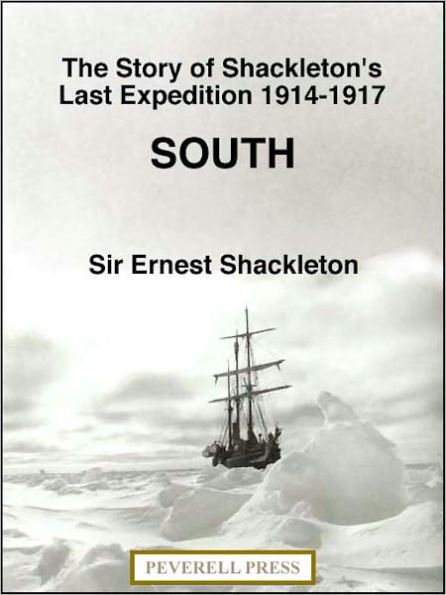Exemplary British expedition leader Sir Ernest Shackleton's (1874-1922) compelling account of his 1914 Imperial Trans-Antarctic Expedition consisting of two ships, the HMS Endurance and the HMS Aurora. The goal of the expedition (which it failed to achieve, but not for want of perseverance) was to cross the Antarctic by dogsled, exploring unknown territory and making scientific observations along the way. The plan called for the Endurance, with Shackleton aboard, to establish a base on the shore of the Weddell Sea, while the Aurora did the same at the Ross Sea on the opposite side of the continent. From the Weddell Sea base a six-man Transcontinental party led by Shackleton would set out for the Ross Sea base by dog sled. However, after arriving in Weddell Sea, the Endurance became trapped in ice floes and was eventually crushed, leaving the twenty-eight members of party to make their way 300 miles across the ice and establish a camp on Elephant Island. From there, Shackleton and five of his men courageously set out by small boat on a sixteen-day journey to Stromness Whaling Station on South Georgia Island to find help, enduring numbing cold, extreme thirst, two fierce gales, and a rogue wave of which he later wrote, ". . . I realized that what I had seen was not a rift in the clouds but [its] white crest . . . During twenty-six years' experience of the ocean in all its moods I had not encountered [one] so gigantic." On finally reaching Stromness, Shackleton immediately set about returning to Elephant Island to rescue the men he had left there. After several unsuccessful attempts, he finally reached them just as their supplies were running out. Returning to New Zealand, he then sailed to the Ross Sea base to retrieve the expedition's second party, which he learned had been left stranded there when the Aurora had become trapped in pack ice eight months earlier. It is a tribute to Shackleton's remarkable energy, his tireless persistence, and his admirable leadership qualities that all members of the Weddell Sea party survived the extraordinary hazards and dangers encountered by the expedition, as did all but three members of the Ross Sea party. Though overshadowed at the time by the outbreak of World War I, the feats of Shackleton and his companions in this expedition are now recognized as ranking among the most memorable in the annals of Antarctic exploration.
1100059722
South
Exemplary British expedition leader Sir Ernest Shackleton's (1874-1922) compelling account of his 1914 Imperial Trans-Antarctic Expedition consisting of two ships, the HMS Endurance and the HMS Aurora. The goal of the expedition (which it failed to achieve, but not for want of perseverance) was to cross the Antarctic by dogsled, exploring unknown territory and making scientific observations along the way. The plan called for the Endurance, with Shackleton aboard, to establish a base on the shore of the Weddell Sea, while the Aurora did the same at the Ross Sea on the opposite side of the continent. From the Weddell Sea base a six-man Transcontinental party led by Shackleton would set out for the Ross Sea base by dog sled. However, after arriving in Weddell Sea, the Endurance became trapped in ice floes and was eventually crushed, leaving the twenty-eight members of party to make their way 300 miles across the ice and establish a camp on Elephant Island. From there, Shackleton and five of his men courageously set out by small boat on a sixteen-day journey to Stromness Whaling Station on South Georgia Island to find help, enduring numbing cold, extreme thirst, two fierce gales, and a rogue wave of which he later wrote, ". . . I realized that what I had seen was not a rift in the clouds but [its] white crest . . . During twenty-six years' experience of the ocean in all its moods I had not encountered [one] so gigantic." On finally reaching Stromness, Shackleton immediately set about returning to Elephant Island to rescue the men he had left there. After several unsuccessful attempts, he finally reached them just as their supplies were running out. Returning to New Zealand, he then sailed to the Ross Sea base to retrieve the expedition's second party, which he learned had been left stranded there when the Aurora had become trapped in pack ice eight months earlier. It is a tribute to Shackleton's remarkable energy, his tireless persistence, and his admirable leadership qualities that all members of the Weddell Sea party survived the extraordinary hazards and dangers encountered by the expedition, as did all but three members of the Ross Sea party. Though overshadowed at the time by the outbreak of World War I, the feats of Shackleton and his companions in this expedition are now recognized as ranking among the most memorable in the annals of Antarctic exploration.
2.99
In Stock
5
1

South
Related collections and offers
2.99
In Stock

Product Details
| BN ID: | 2940015565225 |
|---|---|
| Publisher: | InfoStrategist.com |
| Publication date: | 03/23/2004 |
| Sold by: | Barnes & Noble |
| Format: | eBook |
| File size: | 557 KB |
From the B&N Reads Blog
